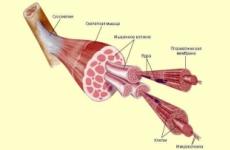Fire protection measures. Fire protection systems ensure the safety of the house and enterprise
System fire protection - This is a combination of organizational events and technical means aimed at preventing the impact on people of dangerous factors of fire and limit the material damage from it. According to GOST 12.1.004-91, fire protection is achieved by the following requirements:
- the use of fire extinguishing equipment and the corresponding types of fire equipment. These include: primary fire extinguishing means (chemical foam, air-foam, carbon dioxide fire extinguishers; carbonic acid-bromoethyl, powder fire extinguishers and fireproof water supply, see Fig. 1) and mobile means (fire trucks, autoatsos, motor-pumps, fire trains, boats, tanks, airplanes, etc., see Fig. 2). Chemical and air-foam fire extinguishers cannot be used to extinguish electrical installations under stress, as well as alkali metal and their carbides, since water is included in the foam. Carbon dioxide fire extinguishers cannot be used to extinguish hydrophilic LVZ (alcohol, acetone, etc., in which it is preserved soluble, driving substances, as well as substances that can burn without air access (celluloid, magnesium, etc.). For all listed means and species Technicians must be defined by regulatory (calculated) reserves.
- application of automatic fire alarm and fire extinguishing installations. Automatic installations are powered by sensors (detectors, see Fig. 3), which, depending on the acting fire factors, are divided into: thermal, smoke and light. Fire communication and alarm system by telephone special or general purpose, radio communications, electrical fire alarm (EPS) and sirens;
- application of building materials with normalized indicators fire danger ;
- application of impregnation of objects of objects with antipirens and applying them on the surface of flame retardant paints. For example, liquid glass.;
devices that ensure restriction of fire distribution.
These include: fire barriers in buildings and individual devices; devices for emergency shutdown of installations and communications; Funds preventing (limiting) spill and spreading fluids during fire, etc. ;
- using technical means of warning and evacuation of people. The evacuation of people should be completed before the maximum permissible values \u200b\u200bof dangerous fire factors, and during the inexpediency of evacuation, people should be protected in the object. For this, the required amount, dimensions and constructive execution must be installed evacuation paths and outputs. If necessary - light pointers, sound and speech alerts ;
- the use of collective funds (protective structures and other fireproof zones) and individual protection of people from dangerous fire factors;
- Application of copper protection . They should ensure uninfection, decrease in temperature and removal of combustion products and thermal decomposition on people's evacuation paths. These include powerful ventilation plants, air ducts, refrigeration machines, air conditioners and other devices. Typically, these devices have a double purpose: under normal conditions provide a normal course of the technological process, and during the fire they are switched to the supply of pure and cooled air in evacuation paths.
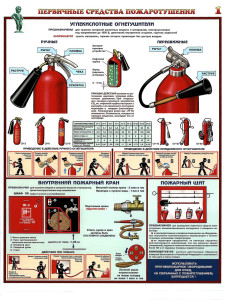
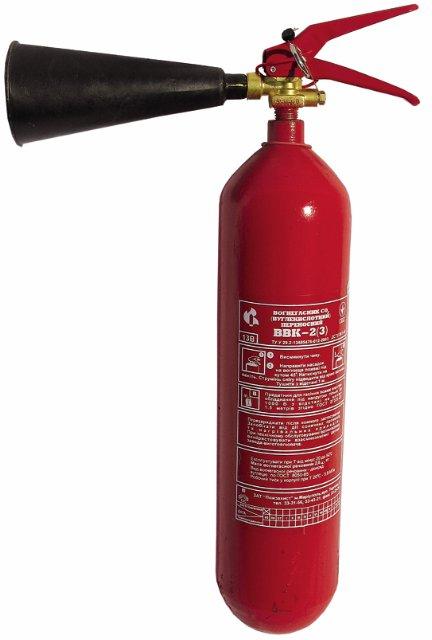
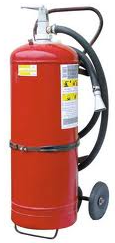
but -fireman b -fire extinguisher in -fire extinguisher
shields inventors
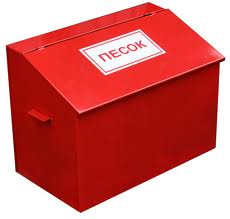
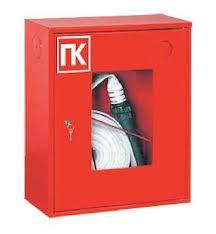
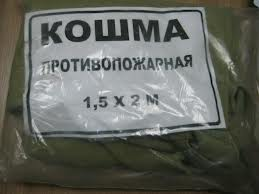
g -box d -firefighter E -fire fire
with Pescomcranflower (Shot)
Figure 1 - Primary Fire Extinguishing Means

but -fire engine b -fire tank in -mobile
motor POMPA
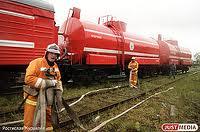
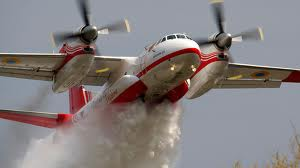
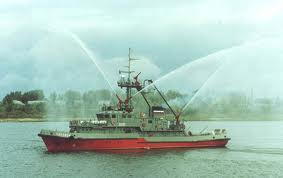
g -fire train d -fireman E -fireman ship
Figure 2 - Mobile fire extinguishing
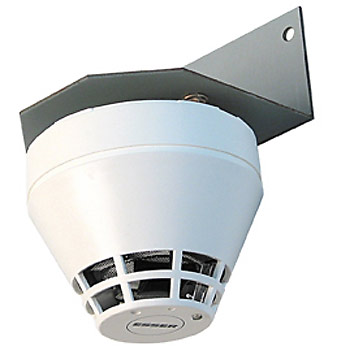
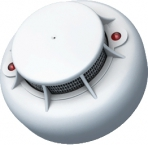
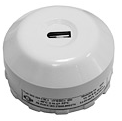
but -thermal DTL. b -smoke IP 212-189 in -light IP-329-CI-1
Figure 3 - Detectors
4.9 Organizational and Technical Events:
According to the current legislation, the responsibility for the maintenance of an industrial enterprise in the appropriate fire fighting is imposed directly on the head (owner). The owners of enterprises, institutions and organizations, as well as tenants, are required to carry out organizational and technical measures. The main activities include:
- passportization of substances, materials, products, technological processes, buildings and structures of objects in terms of provision fire safety . Passportization includes information about their quantitative composition, timing and storage location (location);
- organization of training working fire safety rules;
- propaganda fire safety measures, including the manufacture and use of visual agitation;
- development and implementation of the norms and rules of fire safety, instructions on the procedure for circulation of fire hazardous substances and materials, on compliance with the fire regime in the actions of people in the event of a fire;
- Development of measures for the actions of the administration, workers and employees in case of fire and the organization of the evacuation of people;
- carrying out a service investigation of cases of fires;
- ensuring the availability and efficiency of the necessary fire equipment. The used fire technician should ensure effective fire extinguishing (sunbathing), be safe for nature and people.
Evacuation of people from buildings and structures
To protect people from agrowing factors The fire needs to be enacted as soon as possible.
Evacuation of people in the fire – this is forced organized
the process of moving people from the zone where it is possible to affect them dangerous factors of fire , outward or other safe zone.
Evacuation is also considered to be the inapplying movement of people relating to low-friendly groups of the population, carried out with the help of the service personnel, the personnel of the fire fighter and so on.
Evacuation is carried out in terms of evacuation paths to evacuation outputs, see Figure 4. An important indicator of its effectiveness, according to GOST 12.1.004-91 "Fire safety", is evacuation timeDuring which people may leave the room or the building as a whole until the critical phase of the fire (the occurrence of critical temperature values, oxygen concentrations, combustion products, etc.). The evacuation time is calculated as the sum of the time intervals when moving in separate areas of the route and is assessed with regard to:
The volume of the room.
So, for example, for explosion hazardous premises (Categories A and B) of up to 15,000 m  buildingsI.,
II.,
III The degrees of fire resistance, the permissible evacuation time is 0.5 min., And for fire hazardous premises (category B) - 1, 25 min.
buildingsI.,
II.,
III The degrees of fire resistance, the permissible evacuation time is 0.5 min., And for fire hazardous premises (category B) - 1, 25 min.
To provide safe evacuation A number of requirements are presented to production buildings and premises, according to DBN B.1.1.7-2002 "Flashlessness of the Association of People's Budіvnitstva". An important normalized indicator is the maximum permissible distance from the most remote working meta to the nearest output from the room. This distance is determined depending on:
The degree of fire resistance of the building;
Floors of the building.
So, for example, for fire hazardous premises (category B) in buildingsI. andII. The degree of fire resistance having at least three floors, the maximum allowable distance is 75 m.
The number of evacuation outputs must be at least two. They should be dispersed. Minimum distance  Between the most remote evacuation outputs from the room is determined by the formula
Between the most remote evacuation outputs from the room is determined by the formula
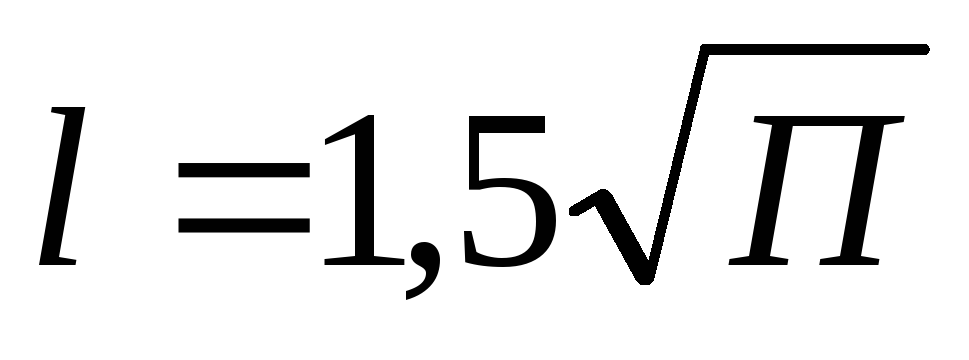 ,
(1)
,
(1)
where P - Perimeter of the room, m.
In some cases, it is allowed to provide one evacuation output from the room, for example, when there are no more than 50 people in it, if the distance from the most distant floor point before the specified output does not exceed 25 m. Height and width of evacuation paths is calculated according to regulatory documentation in accordance With the appointment of the building. But at the same time, the height should be at least 2m, and the width is not less than 0.8 m. Along the path of evacuation, there should be no thresholds above 0.05 m. The stairs must be equipped with railings. Doors should open out. Evacuation exits, the paths of evacuation should have designations using fire safety signs according to GOST 12.4.026-76 "CBST. Colors signal and safety signs ", see fig. five.
Outputs are considered evacuation if they are conducted from the premises:
The first floor outside directly or through the corridor, the staircase, the lobby;
Any floor In addition to the first leading to the staircase. In this case, the staircases must have a way out directly or through the lobby;
In the nearby room on the same floor, provided by the above outputs.
In each production room there should be an evacuation plan with a detailed indication of the route, fire safety signs and persons responsible for fire condition, see Fig. 6. The plan is necessary for a preliminary careful study by all employees of the production unit, which, if necessary, will allow evacuation organized and efficiently.
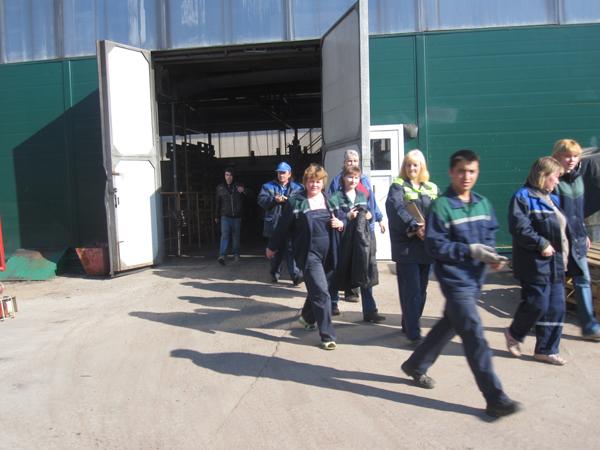
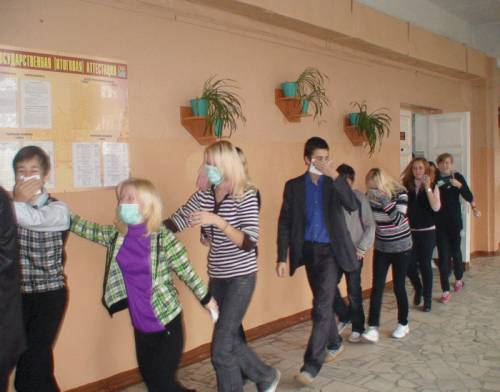
Figure 4 - Evacuation examples for fire
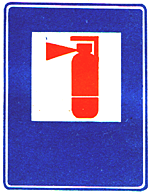
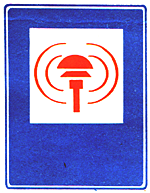
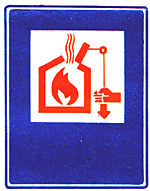
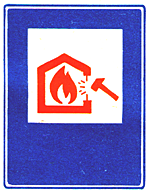
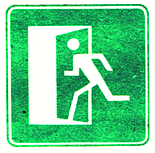
a B C D E
a - fire extinguisher; b - point notice of fire; in - O.rgana control smoke and Heat Supply Systems; Mr. M.eato autopsy design; D - exit here.
Figure 5 - Fire safety signs used in evacuation
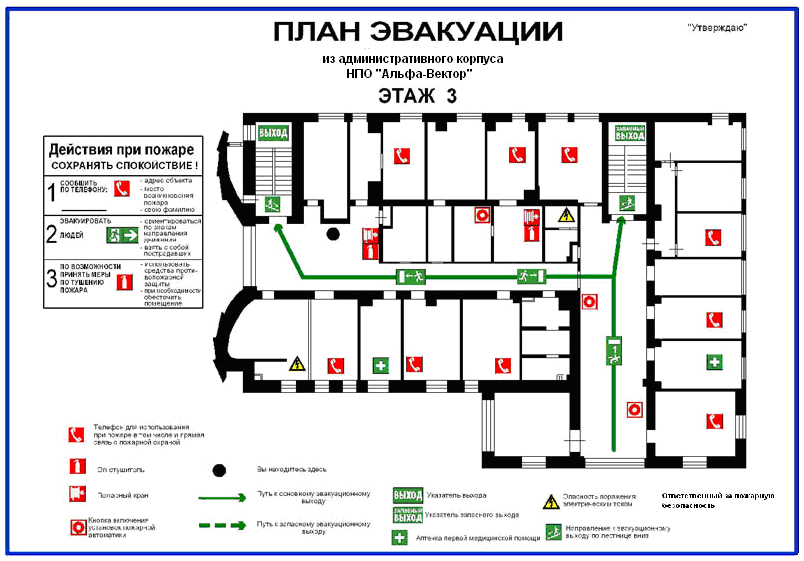
Figure 6 - Evacuation plan from the administrative building of the enterprise
Lightning protection
Lightning protection is a set of events and means aimed at protecting objects from lightning.
Statistical data indicate that on average, about 44,000 thunderstorms occur on the globe per day. Losses only from fires and explosions caused by this phenomenon, colossal. The cost of carrying out massive lightning protection measures over the past 5 years is approximately 1.5 times less than the value of burnt buildings and structures.
The main regulatory document determining the necessary measures and facilities for objects up to 150 m is RD 34.21.122-87 "Instructions for the lightning protection of buildings and structures". According to this document, the impact of lightning on objects is customary to divide into two main groups: primary and secondary.
Primary impacts caused by a straight blow of lightning, are divided into:
- electric (lesions of people and animals by electric shock) ;
- thermal.The sharp separation of heat in the current zone may result in ignition;
- Mechanicalwhich are a shock wave capable of deforming and destroying technological equipment and bearing structures.
Secondary exposuresmanifest in the form:
- Intensive electromagnetic field (EMF)caused by moving charges and changing current to the current. This leads to the appearance of high electric potentials on metal constructions, which are also able to affect people and animals;
- skid on the high voltage objecton wires and communications, if they found themselves in the zone of the current specimen.
These impacts should be taken into account in each particular case when developing protective events.
The severity of the effects of the lightning strike largely depends on the explosion or fire hazard of the building (facilities, premises), as well as on other concomitant effects. Therefore, the RD 34.21.122-87 applies a differentiated approach to the implementation of lightning protection, according to which objects are divided into three categories.
To categoryI. Objects include, in normal technological modes, explosive concentrations of gases, vapors, dust, fibers may be formed and form. Any damage to lightning creates increased risk not only for the objects themselves, but also for others, closely located.
To categoryII.believe objects in which the appearance of explosive concentrations is possible with an accident. The probability of a combination of lightning with an accident at the facility is quite small.
To categoryIIIobjects include, the consequences of which are characterized by smaller material damage than with an explosive environment. These are high residential and public buildings, chimneys, towers and towers, minor structures from relatively cheap building materials.
Lightning conductors are divided into separately standing and installed on the object itself.
For category objectsI., characterized by high risk of lesions of people in case of lightning and significant material losses , it is necessary to use separate lightning lighters. They are performed using vertical rods (see Fig. 7 a) or using a horizontal cable (see Fig. 7 b), and the lightning current is spreading, bypassing the object. With a single rod lightningness, the protection zone has a cone shape.
When using a metal roof, lightning equipment is the roof itself (see fig. 7 V). Clakes connected to it should be arranged at least than 25 m. As currents, steel structures of the building should be used (columns, farms, fire stairs, etc.), connected to the earthing.
On buildings and structures with non-metallic roofing, a lightning grid can be used, made by welding from steel wire with a diameter of at least 6 mm with a cell size of not more than 6 m and laid on the roof from above or below waterproofing (see Fig. 7 g).
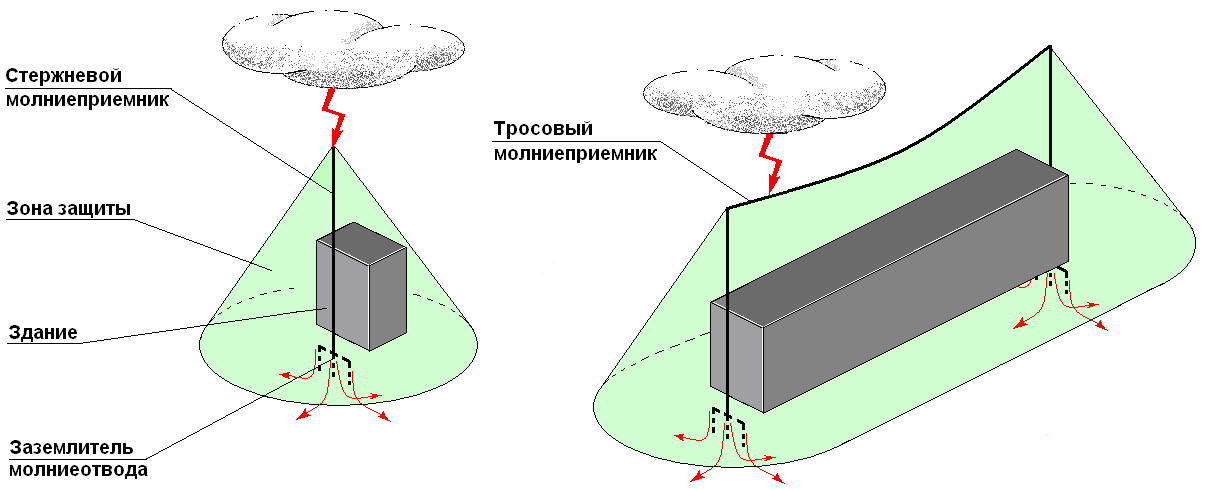
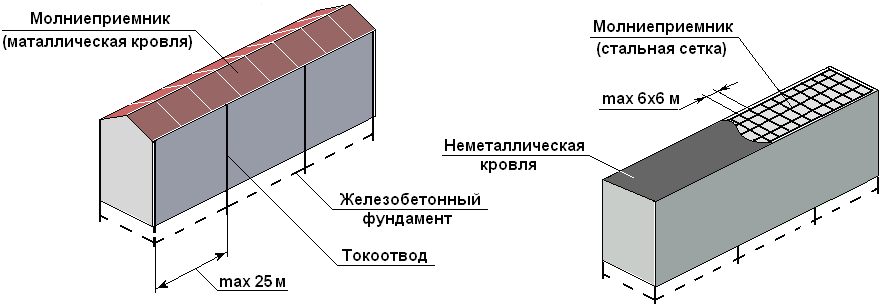
Figure 7 - Lightning protection devices for buildings
If the lightning protection is made by directly the installation of rod or cable lightning games on the object, then at least two recesses should be from each rod or rack.
It should use typical (normalized) constructs of reinforced concrete foundations, according to RD 34.21.122-87. If the existing foundation of the building does not meet these requirements, artificial earthing is performed.
Constructive-geometric dimensions of various lightning protection devices and their protective zones are calculated according to the method described in the RD 34.21.122-87, taking into account the average annual duration of the thunderstorm for the specified area.
To reduce the likelihood of fire, various methods of protection are used. Improving existing technologies in the field of security systems and equipment allows you to display fire protection for a new, more efficient level.
The concept of fire protection
Fire protection includes all possible events, technologies, the main purpose of which is to reduce either the complete exclusion of the probability of fire, as well as minimizing the material damage caused by fire.
Specific anti-fire protection methods can be divided into:
- Passive - aimed at preventing fires.
- Active - direct salvation of material values \u200b\u200band people during a fire.
Preventive measures
Measures to prevent fires include the following:
- application special fire retardant impregnations For passenger cars finishing materials (wood, fabric, paint, plaster), which increases their resistance to the action of very high temperatures;
- electrical wiring isolation in order to prevent short circuit;
- ensuring non-combustible grounds for laying wires and cables;
- installation of protective shutdown devices (UZO) or circuit breakers (AV) - it allows you to avoid a fire and shock in case of damage to the insulation for the light of automatic shutdown of the electric current to achieve a certain amount of them;
- separation of wooden furniture items from gas or electric stove;
- isolating sockets located in rooms with high humidity (bathroom, bathroom) or on the outer walls;
- the use of special heat-resistant ashtons to extinguish cigarettes, matches;
- ignition decorative candles only in stands, etc.
Active defense
How to protect a person as much as possible if he found himself in a burning building? The right architectural and planning solutions come to the rescue, because from them, among other things, it will depend on how fast people and effective will be the evacuation of people. For example, in the requirements for evacuation paths there are the following items:
Active fire anti-flame activities include the use of manual fire extinguishers, sand, any other non-combustible materials or the launch of an automatic fire extinguishing system.
Passive fire protection methods
Passive protection of various objects - enterprises:
- production;
- industrial;
- construction;
- trade;
- banking;
- research and so on - - -
carried out without direct human participation. In particular, they include the installation of such systems as:
- automatic fire alarm;
- fire extinguishing;
- fire alerts;
- video surveillance;
- access control as well
- fireproof different materials and structures.
A complex of such systems at the facility provides it. fire safetyand more specifically responsible for:
- timely warning about fire;
- automatic control and control of PB technical devices;
- activation of extinguishing systems and removal of smoke without human participation (automatically);
- providing information about evacuation paths;
- automatic opening emergency doors.
Reliable Fire Protection Objects
For installation complex system Fire protection is better to attract specialists in this area.
Our company offers for you design, installation, further maintenance:
- fire alarm, including device alert and evacuation management;
- fire extinguishing systems AUTOMAT (WATER, Foam, Powder or Other will be established depending on the characteristics of your object);
- anti-refinery systems;
- fire protection flammable designs.
Turning to our company, you increase the efficiency of fire protection twice, because the entire system will be mounted taking into account the individual parameters of the object, which will also reduce your costs. Warranty and post-warranty service is the key to the fact that the system will constantly be in working condition and 100% will work in case of danger.
Fire protection at the enterprises is carried out in three areas: professional, administrative, public.
Fire protection system - This is a complex of methods, activities and methods that are aimed at limiting the distribution and localization of a fire, protecting people and material values.
Firefire - This is a combination of fire safety measures, pre-installed for an object or separate room and subject to mandatory execution by all working.
In order to reduce the danger of the emerging fire, measures should be applied to the localization of its distribution. The rate of dissemination of a fire depends largely on what materials are used for the construction of buildings and structures. Construction Materials And the designs react to an increase in the temperature during a fire in different ways: in one case they are quickly exposed to fire, in another - a long time remains carrying the carrying capacity. Section 4.1 provides the classification of materials according to the ability to resist ignition and burning (SNiP II-2-80).
Under fire resistance Understand the ability building structures Resist influences high temperatures In a fire and maintain their operational functions. Fire resistance of building structures is determined based on the test of samples of structures in special furnaces and is characterized by a given design of fire resistance limit, which is determined by time (in hours or minutes) from the beginning of the heat test of the structure until one of the limit states of fire resistance occurs:
- a loss carrier ability structures and nodes (collapse or deflection depending on the type of construction);
- an increase in temperature that is not heated surface on average by more than 160 ° C compared with the temperature of the construction to the test (the construction has heat insulating capacity);
- Education in designs through cracks or through holes through which burning products or flame penetrate.
For external walls, coatings, beams, farms, columns and columns by the limit state is only the loss of the carrying capacity of structures and nodes.
Buildings and facilities for fire resistance are divided into five degrees (I-V). The degree of fire resistance is characterized by the limit of fire resistance of the main building structures and the limits of the spread of fire according to these structures. The spread of fire for construction structures is determined on the basis of tests of samples in special furnaces. The size of the damaged sample zone in the plane of structures from the border of the heating zone, perpendicular to the damaged damaged, is perpendicular to the most remote damage point (for vertical structures - up, for horizontal - in each direction). The building meets the requirements of fire resistance if the condition is satisfied:
where about f - the actual degree of fire resistance of the building, about the TP - the required degree of fire resistance to SNiP.
When determining the degree of fire resistance of the building and its structures, as well as at large-planned decisions of the building, the likelihood of the occurrence and distribution of fire (explosion), the size and nature of the consequences of accidents take place.
SNIP II 90-81 " Production buildings industrial enterprises»Production on the explosive, explosion and fire hazard is divided into six categories: a and b - explosion hazardous; In, g, d - fire hazard; E - Explosive.
Categories of production is based primarily on the properties of substances used in production. It is also taken into account the possibility of the formation of explosive mixtures in an amount representing the risk of the destruction of the building in the case of an explosion. It is adopted that the volume of the explosive mixture, which makes up 5% and less than the volume of the room, does not cause the destruction of the main building structures. The calculation of the formation of gases, liquids and dust of the explosive mixture in a volume exceeding 5% of the volume of the room is set out in CH 463-74.
To prevent the dissemination of a fire from one building or facilities to another, there are certain distances between them, called fire gaps.
The magnitude of the fire gap depends:
1) degree of fire resistance of buildings and structures;
3) the presence and area of \u200b\u200blight openings;
4) lengths and floors of buildings.
Devices designed to limit the spread of fires and sunbathing in buildings are called fireproof obstacles. These include walls, partitions, overlaps, doors, gates, hatches, tambour gateways and windows.
Firewalls should be based on the foundations or foundation beams, erected into the entire height of the building or structure and divide the structures (overlaps, coatings, lights, etc.). In the fire walls, it is allowed to organize ventilation and smoke channels so that in places of their placement the limit of fire resistance of the fire wall on each side of the channel was at least 2.5 hours.
29 April, 2015
Alexei
By the number of gone and the magnitude of economic damage, the fire is undoubtedly the leader among all sorts of disasters that lie down. In the era of widespread use of electricity, the problem is becoming increasingly relevant, because now the danger of fire exists not only in places with the presence of open fire, but also where there is electrical wiring, electrical appliances and electrical equipment, that is, almost everywhere. That is why the design of buildings or objects of industry fire protection is the most important task.
Prevention fires
Fight with fires should be started with the prevention, which is:
- Developing and implementing fire standards and rules;
- Accounting for fire safety requirements at the design stage;
- Organization timely maintenance fire protection systems;
- Content in the readiness of fire fighting and their improvement;
- Regular fire and technical inspection of residential and public buildings, industrial and agricultural facilities.
Primary fire safety measures
IN this group fire fighting events The following is:

Active Fire Protection Methods
Measures taken within the framework of the active fire protection, pursue two goals:
- Alerts of people about began fires;
- Fire extinguishing.
Designing automatic fire protection systems, developers strive first of all to ensure the possibility of fire registration at the earliest stage. Such an approach will allow minimizing the threat to the health of people and their lives, as well as losses material property. Components of automatic fire extinguishing systems are:
- Substance whose distribution allows you to pay off;
- The supply system equipped with adjusting valves;
- Sensors for detecting fire;
- System of sound and visual alert.
After the automatic fire protection systems received quite widespread, the number large fires It was noticeably declined, losses from them significantly decreased. The work of the systems, first of all, evaluated construction and insurance companies. The latter today is not even taken to insure an object that has no fire automation.
Watch the video O. automatic systems Fire protection:
Recently funds automatic fire extinguishing began to combine with complexes preventing unauthorized access to the object. Such fire fighting and security systems for the year are becoming increasingly popular. Their installation and customization require less forces and costs than the installation of fire protection and "security" systems separately.
Passive fire protection
The task of passive protection against fire is as follows:
- Prevent the spread of fire or at least slow down this process;
- To do possible evacuation people from a burning building;
- Recove the structures of the building or structures from the collapse due to the effects of the fire.
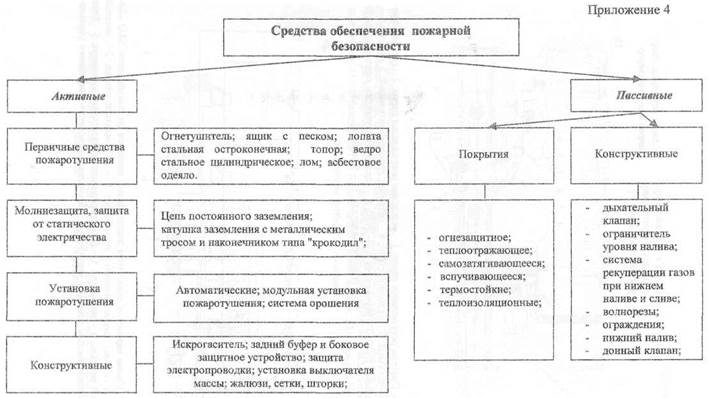 The advantages of protective measures of passive nature include their low cost, as well as what, unlike, for example, from systems of fire and security protection, their operation is not related to the operation of any devices, and therefore eliminates the possibility of breakdowns and failures. Passive fire protection measures include:
The advantages of protective measures of passive nature include their low cost, as well as what, unlike, for example, from systems of fire and security protection, their operation is not related to the operation of any devices, and therefore eliminates the possibility of breakdowns and failures. Passive fire protection measures include:
- The device of fire walls and partitions with filling of openings with refractory structures;
- Device of fire overlap, zones and valves;
- The use of non-combustible and non-smoke of building materials;
- Fire protection of metal structures forming the carrier building frame;
- Application fire retardant colors, varnishes and plasters on reinforced concrete structures;
- The use of non-combustible facade insulation;
- The device of the belts of fire glazing on the facades (using refractory polymer films).
Not only fire protection protection of metal structures can be considered passive measures, but also replacement (in the design stage) metal carcasov Reinforced concrete, which demonstrate higher fire resistance. Methods of passive fire protection engineering communications:
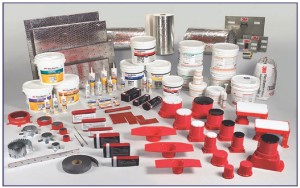
The use of passive methods of combating fires does not exclude the installation of the fire protection system, on the contrary, active and passive fire protection must work together.
Types and types of protection systems
Used today fire retardant systems are divided into two varieties:
- Independent;
- Fire and security systems.
The installation of security and fire alarms allows to ensure the safety of the enterprise in the complex, reducing the cost and significantly increasing its effectiveness.
 Such alarm combines three functions:
Such alarm combines three functions:
- Tracking attempts to unauthorized penetration on a protected object and notification of them;
- Detection of fires;
- Automatic fire extinguishing.
The benefit from such an association is obvious: one control panel is used to control the entire complex.
Therefore, install and exploit it is much easier. In addition, with such a combination of the fire and security protection system, complement each other, mutually compensating for the flaws peculiar to them. So, for example, video surveillance means security systemSignificantly increase the efficiency and efficiency of fire protection systems.
Types of fire detectors
A key element of fire automation is a fire detector (something else is called a sensor). Detectors are the following types:
- Thermal;
- Smoke;
- Gas;
- Flame (light);
- Combined.
If the magnitude of the controlled parameter exceeds the maximum allowable value (for threshold detectors) or its speed is too large (for differential detectors), the signal enters the receiving and control panel that runs the automatic fire extinguishing system.
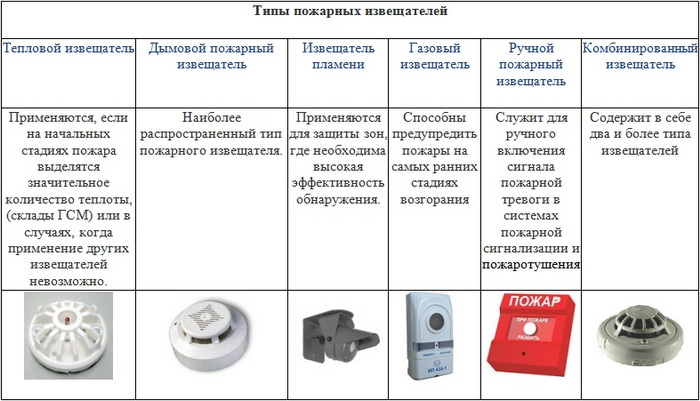 To ensure the reliability of the complex, the use of means of protection of metal structures of fire, which are mounted devices for generation, feeding and spraying a flame substance. Detectors of fire and security systems can be:
To ensure the reliability of the complex, the use of means of protection of metal structures of fire, which are mounted devices for generation, feeding and spraying a flame substance. Detectors of fire and security systems can be:
- Point;
- Linear.
The first control the changes in the parameters in the small area, the second - in the sections of any length. Linear sensors have a cable appearance and mounted, as a rule, cable channels. Previously used heat-sensitive cables subject to the influence of vortex currents and other electromagnetic interference. IN modern systems Fire and security protection uses a more advanced variety of linear sensors - fiber-optic cables.
The maintenance of fire protection systems, as well as their installation, is entrusted by specialists. high level And with good luggage knowledge in the head. With incorrect assessment of the situation at the facility or inept installation, the effectiveness of the security system can significantly be reduced.
Conclusion
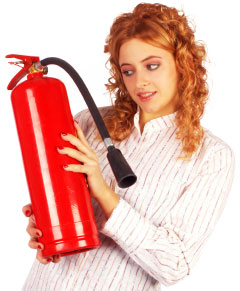 Fighting fires - an advanced border of the scientific and technical revolution. Newly minted technologies, if possible, immediately find application in this area. Evidence of this is the popular fire and security protection systems, sensors and much more.
Fighting fires - an advanced border of the scientific and technical revolution. Newly minted technologies, if possible, immediately find application in this area. Evidence of this is the popular fire and security protection systems, sensors and much more.
But even the most advanced fire protection systems will not be able to secure our homes and enterprises from the fire catastrophe if each of us will not fully realize the entire threat that negligee towards fire entails.
Compliance with the requirements of fire safety will protect the object from material damage and will save the lives and health of people.
Modern construction facilities require a completely new approach to ensuring their fire fighting products and events. If earlier it was possible for one of the fire protection systems to output one general signal about the detection of a fire or smoke, now it is simply irrelevant. Developed special automatic Fire Protection Systems And they need to be able to properly manage. Need to find optimal options Office control automatics to protect people, material values \u200b\u200band, finally, the integrity of the buildings themselves. The construction of huge shopping and entertainment complexes, hospitals with the latest equipment costs, new production areas is quite expensive and it is necessary to take all measures to preserve them.
The main requirements for fire-fighting automation systems are considered:
- early detection of the focus of fire;
- timely transmission of all possible signals, for the speedy connection of fire automation: smoke systems, descent of all elevators down, disconnecting running ventilation systems, launching automatic and other activities necessary in the current situation;
- alerts of people remaining in the building, duty officers about the established fire atmosphere.
However, many simply do not remember that the fire-based protection system is in the state of duty and no action for the fulfillment of these requirements does not produce.
The task of fire protection systems
The task of systems is reduced to identifying frequent false positives that make money losses to companies. This article does not have to give such examples, as they are known, a large number of. The main thing is to prevent their implementation, but to take all measures to a reliable rapid detection of the source of fire.
It turns out that you need to simultaneously perform two contradictory conditions. Namely: increase the likelihood of fire detection, but to do it in the early stages, that is, it is practically not spent on the right detection. It is difficult to work that combines these requirements. However, it is possible if you go along the way to develop high-tech and reliable detection methods.
The second, no less important problem, the prestigious protection system , most of the time in standby mode in every minute readiness. A person to identify the emerging failures on a huge object is extremely difficult. Can be used to check special address modules with feedback to know exactly how correctly the command is executed from the control panel and whether all components are operating correctly in the system automatic protection. But these systems are not distributed in the market fireproof materialsThey are very small, and the installation and implementation of them on the facility costs too expensive. Therefore, they are used very rarely.
Now consider how in detail the information on the object is on the system triggering fire alarm. Basically, long-known threshold detectors are used, and they are trying to combine them in the loop, saving cash Enterprises. It is clear that informative, which one should have, no one has.
However, it is necessary that each system of comprehensive fire-fighting automatic protection protects on a specially developed and approved algorithm clearly, simply, cycling all the necessary firefighters and engineering systems.
Develop detailed algorithm You can work in a specialized company ABC Stroy Protection. For more detailed information You need to contact your company directly or first familiarize yourself with the information on the company's website.

